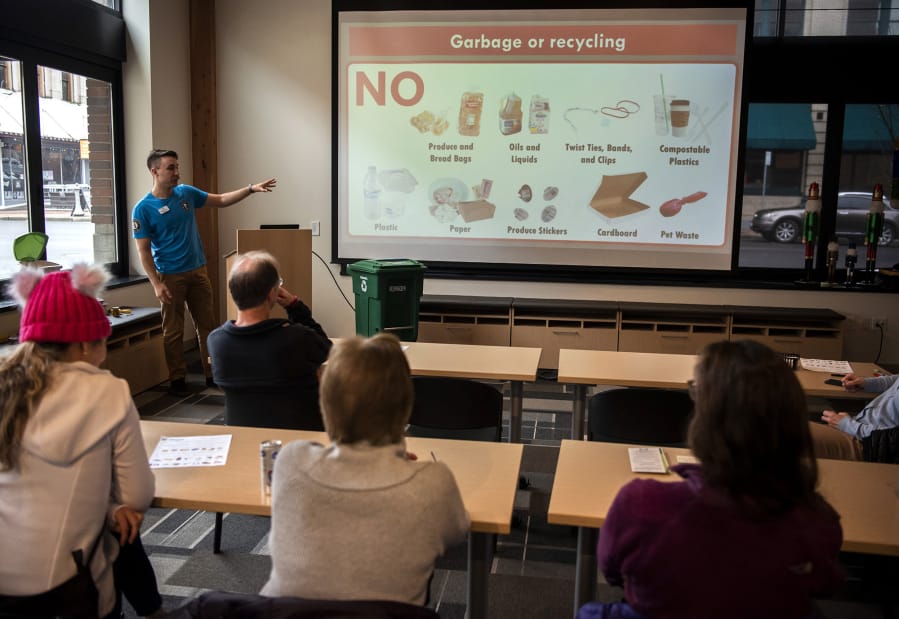You’re not the only one still trying to figure out the curbside organics collection service rolled out in October for Vancouver residents.
That’s why the city and Waste Connections are offering classes to explain the ins and outs of the new service. The program lets you put food waste with your yard debris in what’s now called an “organics” cart.
The service currently is available only inside Vancouver city limits, but may eventually be introduced in unincorporated Clark County.
Even those who have kept their own home compost pile may be a bit befuddled, so we went to the Dec. 13 “Organics 101” class to get answers.
Organics 101 classes
Vancouver will offer “Organics 101” classes at these times and locations:
• 5:30 p.m. Jan. 21 at Vancouver Fire Station 2, 2106 Norris Road.
• 5:30 p.m. Feb. 20 at Waste Connections, 12115 N.E. 99th St., Suite 1830.
• 12:30 p.m. Feb. 22 at Vancouver Community Library, 901 C St.
Additional classes will be offered in March, April and May. Registration required.
For more information, visit www.cityofvancouver.us/publicworks/webform/recycleu-class-schedule-sign-ups.
Yes, you really can put meat in there.
And cheese, leftovers scraped from your dinner plate, and other things you would never put in your home compost pile. The food waste, along with yard debris, gets trucked to Dirt Hugger, an industrial-scale composting operation in Dallesport. An aeration system keeps the waste at temperatures as high as 170 degrees — hot enough to handle meat and dairy, as well as kill seeds and bad bacteria. The introduction of air also means that the waste doesn’t create methane, a greenhouse gas, as it breaks down like it would in the landfill.
No, you can’t slip anything into your organics cart that isn’t food (or yard debris).
You might add shredded newspaper to your home compost pile to balance so-called green and brown material, but it shouldn’t go in your organics cart. Nor should you put paper, cardboard or dog poop in your cart. Pick the stickers off produce. You can toss in coffee filters and even tea bags but pull the string, tag and staple off first.
No, you don’t have to line your pail with compostable plastic bags.
Vancouver’s existing yard debris customers automatically received a kitchen pail for food waste, and it came with a few compostable plastic bags to use as liners. But Dirt Hugger doesn’t really want those bags in its compost. They don’t break down at the same rate as the organic material. Plus, they don’t add any nutrients and are easily mistaken for regular plastic, so workers at the facility pick the bags out.
“You don’t need them,” said Shane Carter, an AmeriCorps environmental educator who works for Vancouver. “But if it helps you use the composting program, go ahead.”
Some people just can’t stand cleaning out an icky pail. If you do line your kitchen pail with a compostable plastic bag, Carter said it would be great if you dump the contents into the organics cart and throw the bag into the garbage.
No, you don’t have to use the provided kitchen pail.
You might find the pail to be handy, but if you want to use something else in your kitchen to collect food scraps, go ahead.
“I use a sour cream tub,” said Meg Johnson, a waste-reduction educator for Waste Connections of Washington.
But when it comes to placing food waste at the curb, it has to go in an official yard debris/organics bin, available in 20-, 32-, 64- and 96-gallon sizes.
You may want to opt for a size that would be small enough for the gardening offseason, because you can always set out extra yard debris in a kraft paper bag next to the organics bin. But the food waste has to go in the official cart, and the biggest one currently costs $7.43 a month, while the smallest costs $4.43.
Yes, things might get stinky, but they don’t have to.
If you notice your kitchen pail becoming odorous, try keeping it in the refrigerator or freezer.
“It’s a good option to keep things from getting yucky,” Johnson said.
Cleaning the pail with a 1:1 vinegar-water solution also helps. You can also sprinkle baking soda in there to absorb odors, Carter said.
“Trying to manage the potent stuff helps,” Carter said.
As for your outdoor organics bin, keep out of direct sunlight. Rinse it out regularly. And layer the food scraps with yard debris.





